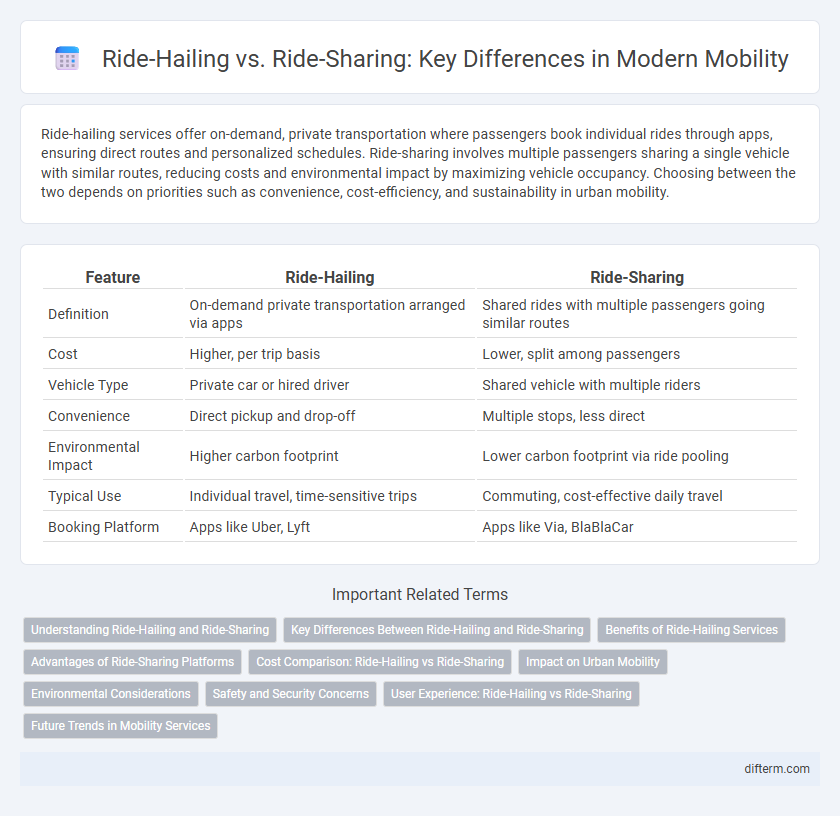Ride-hailing services offer on-demand, private transportation where passengers book individual rides through apps, ensuring direct routes and personalized schedules. Ride-sharing involves multiple passengers sharing a single vehicle with similar routes, reducing costs and environmental impact by maximizing vehicle occupancy. Choosing between the two depends on priorities such as convenience, cost-efficiency, and sustainability in urban mobility.
Table of Comparison
| Feature | Ride-Hailing | Ride-Sharing |
|---|---|---|
| Definition | On-demand private transportation arranged via apps | Shared rides with multiple passengers going similar routes |
| Cost | Higher, per trip basis | Lower, split among passengers |
| Vehicle Type | Private car or hired driver | Shared vehicle with multiple riders |
| Convenience | Direct pickup and drop-off | Multiple stops, less direct |
| Environmental Impact | Higher carbon footprint | Lower carbon footprint via ride pooling |
| Typical Use | Individual travel, time-sensitive trips | Commuting, cost-effective daily travel |
| Booking Platform | Apps like Uber, Lyft | Apps like Via, BlaBlaCar |
Understanding Ride-Hailing and Ride-Sharing
Ride-hailing services, exemplified by companies like Uber and Lyft, provide on-demand private rides arranged through mobile apps, emphasizing convenience and individual transport. Ride-sharing, often associated with carpooling or services like BlaBlaCar, involves multiple passengers sharing a single vehicle to reduce costs and environmental impact. Both models leverage digital platforms but differ primarily in ownership, pricing structure, and social interaction during transit.
Key Differences Between Ride-Hailing and Ride-Sharing
Ride-hailing services, such as Uber and Lyft, connect passengers with private drivers through smartphone apps for on-demand, point-to-point travel, whereas ride-sharing involves multiple passengers sharing a vehicle simultaneously, often with the same or similar routes. Key differences include pricing models, with ride-hailing typically charging per ride and ride-sharing focusing on cost-splitting among passengers. Ride-hailing prioritizes individual convenience and flexible scheduling, while ride-sharing emphasizes reducing costs and environmental impact by maximizing vehicle occupancy.
Benefits of Ride-Hailing Services
Ride-hailing services offer unmatched convenience by providing on-demand transportation with real-time GPS tracking and cashless payment systems, reducing wait times significantly. These platforms enhance safety through driver background checks and ride monitoring features, fostering trust among users. Furthermore, ride-hailing supports urban mobility by integrating with public transit, alleviating traffic congestion and lowering carbon emissions.
Advantages of Ride-Sharing Platforms
Ride-sharing platforms reduce traffic congestion by maximizing vehicle occupancy and lowering the number of cars on the road, leading to decreased carbon emissions. These services promote cost efficiency by enabling passengers to split fares, making transportation more affordable compared to traditional ride-hailing. Furthermore, ride-sharing enhances social connectivity and supports sustainable urban mobility by encouraging collaborative travel practices.
Cost Comparison: Ride-Hailing vs Ride-Sharing
Ride-hailing services typically incur higher costs due to individual pricing models and dynamic surge rates, whereas ride-sharing options distribute expenses among multiple passengers, lowering the per-person fare. On average, ride-sharing can reduce travel costs by 30-50% compared to solo ride-hailing trips, making it a more economical choice for budget-conscious commuters. Cost efficiency in ride-sharing is further enhanced during peak hours and in high-demand urban areas where ride-hailing prices surge significantly.
Impact on Urban Mobility
Ride-hailing services offer on-demand, solo rides that increase vehicle congestion and carbon emissions in urban areas by encouraging private car trips. Ride-sharing promotes carpooling by matching multiple passengers with similar routes, reducing the number of vehicles on the road and lowering traffic congestion and pollution. Urban mobility benefits from ride-sharing through improved traffic flow, decreased greenhouse gas emissions, and enhanced public transit integration.
Environmental Considerations
Ride-hailing services typically generate higher carbon emissions due to increased vehicle miles traveled and frequent empty trips between rides, whereas ride-sharing optimizes occupancy rates, significantly reducing per-passenger emissions. Studies show that integrating ride-sharing can lower urban transportation-related greenhouse gas emissions by up to 30%. Transitioning from single-occupancy ride-hailing to multi-passenger ride-sharing contributes to sustainable urban mobility and mitigates air pollution.
Safety and Security Concerns
Ride-hailing services often face safety challenges due to the variability of drivers and lack of real-time monitoring, increasing risks related to driver background checks and passenger security. Ride-sharing platforms emphasize trust through verified profiles and community ratings, but issues such as passenger privacy and vetting of co-riders remain critical concerns. Implementing advanced GPS tracking, in-app emergency features, and robust driver verification protocols enhances overall safety and security in both mobility models.
User Experience: Ride-Hailing vs Ride-Sharing
Ride-hailing services like Uber and Lyft offer personalized, on-demand transportation with direct routes and quicker pick-up times, enhancing convenience for users seeking immediate rides. Ride-sharing options, including carpooling and shared rides within these platforms, prioritize cost savings and reduced environmental impact but may involve longer travel times and multiple stops. User experience varies significantly between the two, with ride-hailing focusing on speed and privacy, while ride-sharing emphasizes affordability and social interaction.
Future Trends in Mobility Services
Future trends in mobility services emphasize the convergence of ride-hailing and ride-sharing technologies, leveraging AI-driven algorithms for efficient route optimization and reduced wait times. Autonomous electric vehicles are poised to dominate both ride-hailing and ride-sharing fleets, significantly lowering operational costs and environmental impact. Integration with smart city infrastructure enhances real-time data exchange, enabling dynamic pricing and seamless multimodal transportation options.
ride-hailing vs ride-sharing Infographic

 difterm.com
difterm.com